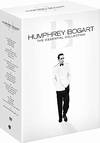





Fred Astaire
Biography | Filmography | Awards | Articles | Bibliography | News | Links | Downloads | Image Credits | Screen Teams: Ginger Rogers and Fred Astaire | FUNNY FACE
| Article 1 |
Obituary: Astaireby John Russell TaylorFilms and Filming, August 1987 page 20-21You're the top! Fred Astaire once worked so hard Thus, respectively, Cole Porter in 1934 and Lorenz Hart in 1940. What they were referring to was already an institution more than half a century ago. Cole Porter at least had good reason to be grateful, for who other than Fred Astaire had made Gay Divorce his biggest success to date in 1933? But the tribute of Rodgers and Hart was quite disinterested: Fred Astaire had never introduced any of their songs, and the nearest he had come to them was with his debt film in 1933, Dancing Lady, in which Nelson Eddy, not he, sang their solitary contribution. But obviously that had nothing to do with the case: if you wanted an instant symbol for the incomparable, Fred Astaire was it. In the late Seventies, just before industrial troubles put it out of circulation for a year, The Sunday Times Colour Supplement was planning a series to be called ‘The Greatest Living', and I was called upon to write the piece about Fred Astaire. The only trouble was, that while we knew he was the greatest living something, we could never decide, in one phrase, they greatest living what. The greatest living dancer? Well, not exactly. The greatest living son-and-dance [sic] man? The greatest living hoofer? Nearer, but still not quite it, because both formulations, and anything similar we could come up with, required one to suppose that he was one, the best, of a classic, rather than one-of-a-kind. And when you come down to it, there never was anyone even vaguely like Astaire. Critics argued for ever about whether he could sing at all, and yet all the greatest creators -- Kern and the Gershwins and Harold Arlen as well as Porter and Rodgers and Hart -- agreed that he had no equal in the delicate art of putting over a sing [sic], even if he croaked it. And when he went into his dance, he just inhabited a different world from the others. In a way, his uniqueness resided, not in any specific technical gifts, but, like all truly great stars' [sic], in her personality. There were a lot of attempts to formulate that too. One of the nearest, in its implications, was the famous observation about his ten-picture teaming with Ginger Rogers, that it worked so well because she gave him sex appeal and he gave her class. Certainly there was something in his attitude to life and to his art which, if not exactly aristocratic hauteur, at least kept everyone and everything at a respectful distance. He had the charm of the Devil, but it never seemed to be deliberately exercised: he presumably hoped you would like him, bit it was not finally important to him whether you did or not. He kept his own integrity, within his own strictly private world, asked for nothing except respect, and how you reacted was entirely up to you. This was no doubt why he succeeded so well in his long succession of solo numbers. There was good reason -- as well as diplomacy -- in his oft-repeated statement that his favourite partner was Gene Kelly. (Kelly always said the same about Fred Astaire.) After all, finally there was not much difference in the nature of the partnership. Significantly, Astaire began his career in a long-sustained brother/sister partnership with Adele Astaire, so there was no real romantic involvement in their dance routines. This was not quite true of his partnership with Ginger, but it always contained a strong element of a sexual rivalry, much less of romantic sentiment. His most notable later partnerships were always with stylists like himself -- Eleanor Powell, Cyd Charisse, or with vulnerable juniors -- Audrey Hepburn, Leslie Caron -- towards whom his attitude was inevitably on the fatherly side of romance. The romantic feeling of his superb ‘Begin the Beguine' with Eleanor Powell is intense, but only because it is distilled to an essence, losing every tincture of the everyday world of beds and babies. And he never seemed to get on very well with such boisterous performers as Judy Garland or Betty Hutton, or with the children Gene Kelly always managed so well. He lived in a world of high style, and that was that. Amazing, then, that he was so universally popular for so long: for who would have thought, seeing this scrawny youngster in his first Broadway starrer (The Bunch and Judy, 1922) that sixty years later he would still be starring (in Ghost Story, 1981), still the greatest? The greatest what? Well it hardly matters, does it? If there ever has been and ever will be only one Fred Astaire, then even superlatives are superfluous. © 1987 Films and Filming |
|
Article 1 |
Article 2 |
Article 3 |
| Now in Print! |
|---|
Buy Videos & DVDs |
|
Buy Movie Posters |
|
Buy Movie Posters |
|
Classic
Movie Merchandise |
|
![]() Printer-friendly version.
Printer-friendly version.
![]() Return
to the top.
Return
to the top.
Last updated:
October 19, 2010.
Reel Classics is a registered trademark of Reel Classics, L.L.C.
© 1997-2011 Reel Classics, L.L.C. All rights reserved. No
copyright is claimed on non-original or licensed material.
Terms of
Use.









